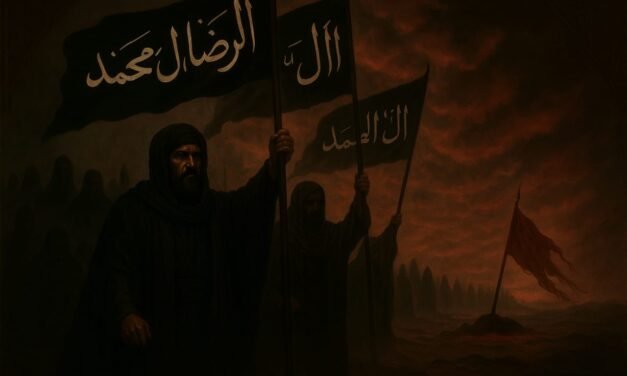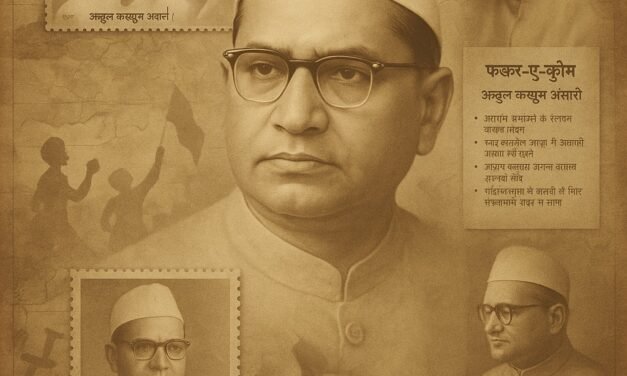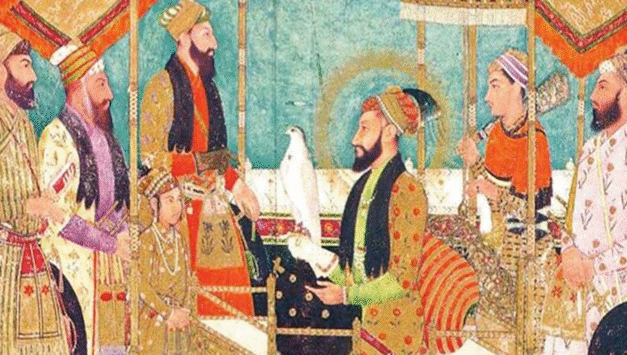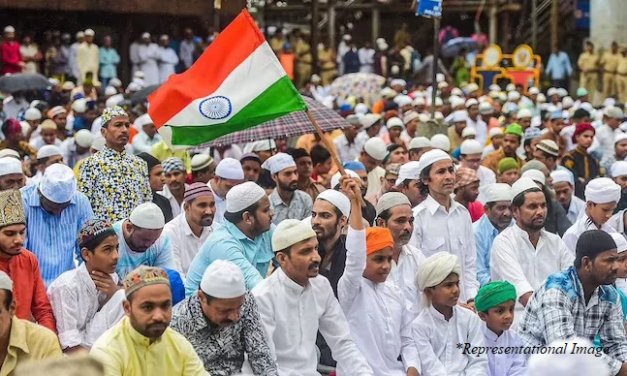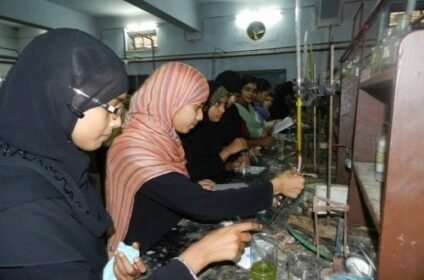Tag: muslim
बिहार से भारत तक: अब्दुल क़य्यूम अंसारी को भारत रत...
Posted by Arif Aziz | Jul 1, 2025 | Biography, Movie Review, Pasmanda Caste, Social Justice and Activism | 0 |
भारत में मुस्लिम शासन का सामाजिक स्वरूप...
Posted by Arif Aziz | Jul 1, 2025 | Culture and Heritage, Education and Empowerment, Miscellaneous, Social Justice and Activism | 0 |
हज: आस्था, एकता और बराबरी की एक रूहानी यात्रा...
Posted by Arif Aziz | Jun 5, 2025 | Culture and Heritage | 0 |
Pahalgam Incident: A Challenge to the Fabric of Ha...
Posted by Arif Aziz | May 13, 2025 | Culture and Heritage, Political, Social Justice and Activism | 0 |
पहलगाम का हमला: भारतीय मुसलमानों का आतंक को करारा ...
Posted by Arif Aziz | May 5, 2025 | Culture and Heritage, Political, Social Justice and Activism | 0 |
Karbala and the Redefinition of Khilafat in Early Islam
by Arif Aziz | Jul 8, 2025 | Culture and Heritage, Education and Empowerment | 0 |
~ Dr. Uzma Khatoon The tragedy of Karbala is one of the most important turning points in Islamic...
Read Moreबिहार से भारत तक: अब्दुल क़य्यूम अंसारी को भारत रत्न देने का समय
by Arif Aziz | Jul 1, 2025 | Biography, Movie Review, Pasmanda Caste, Social Justice and Activism | 0 |
शहनवाज़ अहमद अंसारी उन्होंने बंटवारे का विरोध सत्ता के लिए नहीं, सिद्धांतों के लिए किया।उन्होंने...
Read Moreभारत में मुस्लिम शासन का सामाजिक स्वरूप
by Arif Aziz | Jul 1, 2025 | Culture and Heritage, Education and Empowerment, Miscellaneous, Social Justice and Activism | 0 |
डॉ. ओही उद्दीन अहमदभारत पर पहले भी कई बार मुसलमानों ने आक्रमण किया था, लेकिन 1206 में कुतुबुद्दीन...
Read MoreFrom Bihar to Bharat: Time to honour Pasmanda Patriot, Abdul Qayyum Ansari
by Azeem Ahmed | Jul 1, 2025 | Biography, Social Justice and Activism | 0 |
-Shahnawaz Ahmad Ansari He stood against partition, not for power but for principle.He stood for Pasmandas, not for votes but for equality.He stood for India, not for its fragmentation, but for its integration. In the 21st...
Read Moreमऊ की गलियों में CPI की खोई हुई आवाज़
by Abdullah Mansoor | Jun 15, 2025 | Culture and Heritage, Political | 0 |
लेखक: अब्दुल्लाह मंसूर मऊ जिले में भारतीय कम्युनिस्ट पार्टी (CPI) का इतिहास संघर्ष, विचारधारा और...
Read Moreहज: आस्था, एकता और बराबरी की एक रूहानी यात्रा
by Arif Aziz | Jun 5, 2025 | Culture and Heritage | 0 |
**सारांश (100 शब्दों में):**
हज इस्लाम के पाँच स्तंभों में से एक है, लेकिन यह सिर्फ़ धार्मिक यात्रा नहीं, बल्कि इंसानियत, बराबरी और एकता का प्रतीक है। हर साल लाखों मुसलमान एक जैसी पोशाक में, नस्ल, हैसियत और ज़ुबान से ऊपर उठकर इबादत करते हैं। तवाफ़, सई और अराफात जैसे अमल आत्मसमर्पण, इतिहास और आत्ममंथन का संदेश देते हैं। यह सफ़र सब्र, नम्रता और दूसरों की फिक्र सिखाता है। मैल्कम एक्स जैसे लोगों ने हज के ज़रिए नस्लभेद के खिलाफ नई सोच पाई। हज सिखाता है कि असली पहचान किरदार और नियत में है। यह पूरी इंसानियत को बराबरी और भाईचारे का पैग़ाम देता है।
Read MorePahalgam Incident: A Challenge to the Fabric of Harmony and Peace in the Country
by Arif Aziz | May 13, 2025 | Culture and Heritage, Political, Social Justice and Activism | 0 |
~Dr. Uzma Khatoon The terrorist attack in Pahalgam, Jammu and Kashmir, on April 22, 2025, which...
Read Moreपहलगाम का हमला: भारतीय मुसलमानों का आतंक को करारा जवाब
by Arif Aziz | May 5, 2025 | Culture and Heritage, Political, Social Justice and Activism | 0 |
~ अब्दुल्लाह मंसूर कश्मीर के पहलगाम इलाके में हाल ही में जो आतंकी हमला हुआ, जिसमें 26 मासूम लोगों,...
Read Moreकश्मीर में आतंकवाद के पीछे छिपे सवाल
by Abdullah Mansoor | Apr 24, 2025 | Education and Empowerment, Pasmanda Caste, Political, Social Justice and Activism | 0 |
लेखक: अब्दुल्लाह मंसूर कश्मीर के पहलगाम में हाल ही में हुआ आतंकी हमला पूरे देश को झकझोर देने वाला...
Read MoreZakat: A Pillar of Faith and Social Justice
by Abdullah Mansoor | Mar 22, 2025 | Culture and Heritage, Education and Empowerment, Social Justice and Activism | 0 |
Zakat, a key pillar of Islam, combines spiritual purification with social justice by mandating Muslims to donate 2.5% of their savings to the needy. The Quran emphasizes Zakat’s dual role—cleansing wealth and promoting societal welfare—highlighted in verses like Surah Al-Baqarah (2:110) and Surah At-Tawbah (9:103, 9:60). Zakat fosters equity by addressing poverty and social imbalances. Contrary to misconceptions, Zakat can be given to anyone in need, regardless of faith. In India, where Muslims face significant socio-economic challenges such as poverty and low education levels, Zakat is vital for community upliftment. However, inefficiencies in distribution and lack of transparency hinder its impact. Experts recommend creating a Central Zakat Fund, integrating it with waqf management, and using digital platforms to improve accountability and reach. Strengthening Zakat’s administration will enhance its potential to address poverty and promote justice in disadvantaged communities.
Read Moreपसमांदा आंदोलन का संक्षिप्त इतिहास
by pasmanda_admin | Mar 12, 2025 | Culture and Heritage, Pasmanda Caste, Political, Social Justice and Activism | 0 |
पसमांदा एक उर्दू शब्द है, जिसका अर्थ “जो पीछे रह गया” होता है। यह मुस्लिम धर्मावलंबी दलित, आदिवासी और पिछड़ी जातियों के लिए प्रयोग किया जाता है। इसका इतिहास संत कबीर से जुड़ता है, जिन्होंने इस्लाम में जातिवाद का विरोध किया। बाद में, मौलाना अली हुसैन आसिम बिहारी ने मोमिन कॉन्फ्रेंस की स्थापना की, जो एक संगठित पसमांदा आंदोलन बना। बंगाल में हाजी शरीयतुल्लाह के फरायज़ी आंदोलन और पंजाब में अगरा सहूतरा के प्रयास भी महत्वपूर्ण रहे। महाराष्ट्र में शब्बीर अंसारी ने ओबीसी सूची में पसमांदा जातियों को शामिल कराने की लड़ाई लड़ी। असम में फैय्याजुद्दीन अहमद ने मछुआरा समुदाय के अधिकारों के लिए संघर्ष किया। अली अनवर, डॉ. अय्यूब राईन और अन्य पसमांदा नेताओं ने सामाजिक न्याय के लिए काम किया। आज भी कई संगठन पसमांदा अधिकारों के लिए सक्रिय हैं, और डिजिटल मीडिया के माध्यम से यह विमर्श मुख्यधारा में आ रहा है।
Read MoreWhy women education is important from Islamic point of view
by Abdullah Mansoor | Mar 2, 2025 | Gender Equality and Women's Rights | 0 |
The Prophet also designated specific times to address women’s educational needs. When women requested dedicated instruction, he allocated a weekly session, saying, “Gather on such-and-such a day at such-and-such a place” (Sahih Bukhari 101). This institutionalized women’s access to religious and practical knowledge, showing the importance Islam places on women’s education.Furthermore, the Prophet said, “The best among you are those who learn the Quran and teach it” (Sahih al-Bukhari). This praise extends to women, exemplified by Aisha (RA), the Prophet’s wife, who taught Islamic jurisprudence to male scholars. Another Hadith states, “Whoever follows a path in pursuit of knowledge, Allah will make easy for him a path to Paradise” (Sahih Muslim). The gender-neutral language in these Hadiths underscores equal access to education for both men and women. Throughout Islamic history, there have been many educated Muslim women who made significant contributions. Aisha, the wife of Prophet Muhammad, was renowned for her vast knowledge and taught many people about Islam. Fatima al-Fihri founded the University of Al-Karaouine in 859 CE, which UNESCO recognizes as the oldest continually-running university in the world. Other notable examples include Nafisa bint al-Hassan, a respected scholar who taught Imam Shafi’i, and Lubna of Cordoba, who was well-versed in mathematics and served as the sultan’s secretary.
Read More

